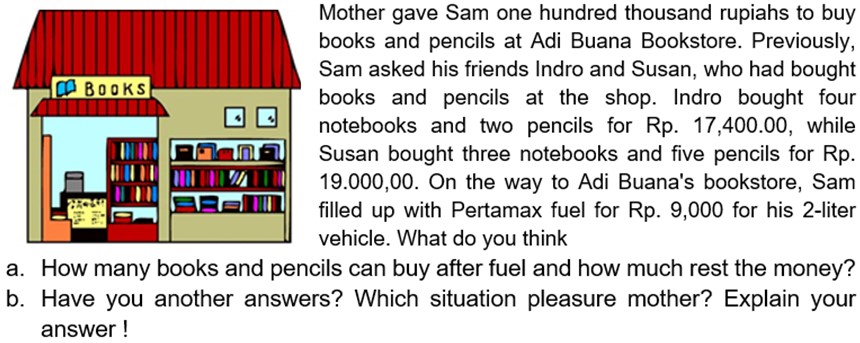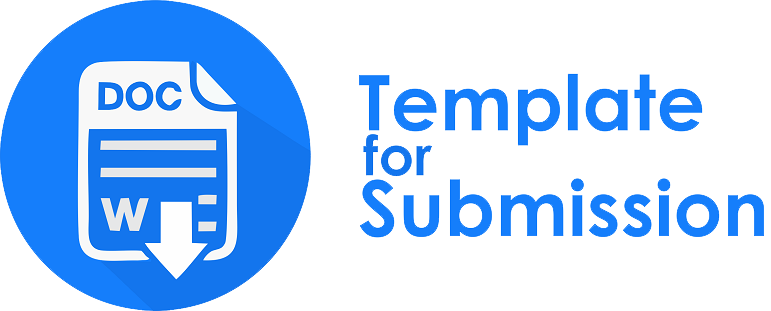HIGH SCHOOL STUDENTS’ CRITICAL THINKING ABILITY
ANALYSIS IN TVLS WORD PROBLEM
Abstract
Problem solving is an important skill, and making decisions about the basis of critical thinking skills. This study is a descriptive qualitative study to describe the critical thinking of 8th grade public junior high school students in the suburbs of Surabaya, East Java in solving TVLS problems. Fifteen junior high school students contributed to the study and were given questionnaires to get three subjects with different critical thinking abilities. Furthermore, each subject was requested to solve TVLS word problems and then interviewed. The instruments used in this study were a critical thinking questionnaire (CTAT), TVLS word problems, semi-structured interview guidelines. The data was analyzed based on indicators that combined the stages of Polya's problem solving and critical thinking. The data were analyzed using critical thinking indicators that have been determined by the authors and the results obtained showed that (1) uncritical and low critical subjects were unable to complete the critical thinking indicators at each stage of problem solving; (2) medium critical, critical, and highly critical subjects were able to complete the critical thinking indicators at each stage of problem solving. For this reason, it is advised that teachers teach their students to think critically in solving problems in every learning process
Downloads
References
Abdiyani, S. S., Khabibah, S., & Rahmawati, N. D. (2019). Profil Kemampuan Pemecahan Masalah Matematika Siswa SMP Negeri 1 Jogoroto Berdasarkan Langkah-langkah Polya Ditinjau dari Adversity Quotient. Al-Khwarizmi: Jurnal Pendidikan Matematika Dan Ilmu Pengetahuan Alam, 7(2), 123–134. https://doi.org/10.24256/jpmipa.v7i2.774
Abidin, Z., Marwan, & nazariah. (2017). Intuisi Siswa SMK dalam Memecahkan Masalah Matematika Ditinjau dari Kemampuan Matematika dan. Jurnal Didaktik Matematika, 4(1), 35–52.
Basri, H., Purwanto, As’ari, A. R., & Sisworo. (2019). Investigating critical thinking skill of junior high school in solving mathematical problem. International Journal of Instruction, 12(3), 745–758. https://doi.org/10.29333/iji.2019.12345a
Benyamin, B., Qohar, A., & Sulandra, I. M. (2021). Analisis Kemampuan Berpikir Kritis Siswa SMA Kelas X Dalam Memecahkan Masalah SPLTV. Jurnal Cendekia : Jurnal Pendidikan Matematika, 5(2), 909–922. https://doi.org/10.31004/cendekia.v5i2.574
Binti, A. (2020). Analisa kemampuan berfikir kritis dan penalaran peserta didik dalam pemecahan masalah matematis dengan model Problem Based Learning. Workshop Inovasi Pembelajaran Di Sekolah Dasar: SHEs Conference Series, 3(4), 633–639. https://jurnal.uns.ac.id/shes
Cahyono, B. (2004). Korelasi Pemecahan Masalah dan Indikator Berfikir Kritis. Jurnal Pendidikan MIPA, 5(1), 15–24.
Doko, M., Sumadji, & Farida, N. (2020). Analisis kemampuan pemecahan masalah matematika siswa berdasarkan tahapan polya materi segiempat. RAINSTEK: Jurnal Terapan Sains & Teknologi, 2(3), 228–235.
Facione, P. a. (2011). Critical Thinking : What It Is and Why It Counts. Insight Assessment, 1(1), 1–28. https://www.insightassessment.com/CT-Resources/Teaching-For-and-About-Critical-Thinking/Critical-Thinking-What-It-Is-and-Why-It-Counts/Critical-Thinking-What-It-Is-and-Why-It-Counts-PDF
Fatmanissa, N., & Kusnandi, K. (2020). Effect of Schema Use in Solving Word Problems : Emphasis on Linguistic Difficulties. Contemporary Mathematics and Science Education, 1(2), 4–9.
Fatmawati, H., Mardiyana, & Triyanto. (2014). Analisis berpikir kritis siswa dalam pemecahan masalah matematika berdasarkan Polya pada pokok bahasan persamaan kuadrat. Jurnal Elektronik Pembelajaran Matematika, 2(9), 911–922.
Hedges, L. E. (1996). Teaching for Connection: Critical Thinking Skills, Problem Solving, and Academic and Occupational Competencies. The Ohio State University.
Hidayat, W., & Sariningsih, R. (2018). Kemampuan Pemecahan Masalah Matematis Dan Adversity Quotient Siswa SMP Melalui Pembelajaran Open Ended. Jurnal JNPM (Jurnal Nasional Pendidikan Matematika), 2(1), 109–118. https://doi.org/10.1016/S0962-8479(96)90008-8
Inayah, S. (2018). Peningkatan Kemampuan Pemecahan Masalah Dan Representasi Multipel Matematis Dengan Menggunakan Model Pembelajaran Kuantum. KALAMATIKA Jurnal Pendidikan Matematika, 3(1), 1–16. https://doi.org/10.22236/kalamatika.vol3no1.2018pp1-16
Jose M Ocampo, J. (2018). Effecting Change on Students?? Critical Thinking in Problem Solving. Educare, 10(2), 109–118.
Mawaddah, S., & Anisah, H. (2015). Kemampuan Pemecahan Masalah Matematis Siswa Pada Pembelajaran Matematika dengan Menggunakag) di SMPn Model Pembelajaran Generatif (Generative Learning) di SMP. EDU-MAT: Jurnal Pendidikan Matematika, 3(2), 166–175. https://doi.org/10.20527/edumat.v3i2.644
Peter, E. E. (2012). Critical thinking: Essence for teaching mathematics and mathematics problem solving skills. African Journal of Mathematics and Computer Science Research, 5(3), 39–43. https://doi.org/10.5897/ajmcsr11.161
Pravesti, C. A., Wiyono, B. B., Handarini, D. M., Triyono, & Atmoko, A. (2020). Examining the effects of guidance and counseling services to the self-regulated learning for college students. Journal for the Education of Gifted Young Scientists, 8(1), 33–45. https://doi.org/10.17478/jegys.664548
Prayitno, L. L., Purwanto, P., Subanji, S., Susiswo, S., & Mutianingsih, N. (2022). Students’ semantic reasoning characteristics on solving double discount problem. JRAMathEdu (Journal of Research and Advances in Mathematics Education), 7(2), 77–92. https://doi.org/10.23917/jramathedu.v7i2.16325
Prayitno, L. L., Purwanto, Subanji, & Susiswo. (2020). Students ’ Behavioral Patterns in Solving Ill-Structured Problems. International Journal of Innovation, Creativity and Change.
Prayitno, L. L., Purwanto, Subanji, Susiswo, & As’ari, A. R. (2020). Exploring student’s representation process in solving ill-structured problems geometry. Participatory Educational Research, 7(2), 183–202. https://doi.org/10.17275/PER.20.28.7.2
Rahimah, N. (2019). Profil Berpikir Kritis Siswa Dalam Memecahkan Masalah Matematika Berdasarkan Kemampuan Matematika. Lentera: Jurnal Pendidikan, 14(1), 37–48. https://doi.org/10.33654/jpl.v14i1.637
Riskiyah, S., Jannah, U. R., & Aini, S. D. (2018). Analisis Kemampuan Berpikir Kritis Siswa SMA Berkemampuan Matematika Tinggi dalam Menyelesaikan Masalah Fungsi. Jurnal Tadris Matematika, 1(2). https://doi.org/10.21274/jtm.2018.1.2.111-122
Sa’adah, M., Susiswo, & Parta, I. N. (2020). Profil Folding Back Siswa dalam Menyelesaikan Soal Cerita. Jurnal Kajian Pembelajaran Matematika, 4(2), 1–8.
Salahuddin, M., & Syahrir, S. (2020). Kemampuan Berpikir Kritis Siswa dalam Memahami Masalah Matematika Materi Fungsi. Jurnal Ilmiah Mandala Education, 6(1), 162–167. https://doi.org/10.58258/jime.v6i1.1122
Sugiyono, D. (2013). Metode Penelitian Kuantitatif, Kualitatif, dan Tindakan. Alfabeta.
Wulandari, S. P., Sujadi, I., & Aryuna, D. R. (2016). Profil Pemecahan Masalah SPLDV dengan Langkah Polya Ditinjau dari Kecerdasan Logis Matematis Siswa. PRISMA, Prosiding Seminar Nasional Matematika, 724–732.
Yuwono, T., Supanggih, M., & Ferdiani, R. D. (2018). Analisis Kemampuan Pemecahan Masalah Matematika dalam Menyelesaikan Soal Cerita Berdasarkan Prosedur Polya. Jurnal Tadris Matematika, 1(2), 137–144. https://doi.org/10.21274/jtm.2018.1.2.137-144.

Copyright (c) 2023 Puput Dwi Agustin, Lydia Lia Prayitno

This work is licensed under a Creative Commons Attribution-NonCommercial-ShareAlike 4.0 International License.
License and Copyright Agreement
By submitting a manuscript to Jurnal Pendidikan Matematika (JUPITEK), the author(s) certify and agree to the following terms:
- Originality and Authority: The submitting author is authorized by all co-authors to enter into this agreement. The manuscript describes original work that has not been published previously in a peer-reviewed journal, nor is it under consideration for publication elsewhere.
- Approval: Its publication has been approved by all author(s) and by the responsible authorities of the institutions where the work was carried out.
- Rights: The authors secure the right to reproduce any material that has already been published or copyrighted elsewhere.
- Licensing and Copyright: Authors retain the copyright to their work.
- License Grant: The authors grant Jurnal Pendidikan Matematika (JUPITEK) the right of first publication, with the work simultaneously licensed under the Creative Commons Attribution-NonCommercial-ShareAlike 4.0 International (CC BY-NC-SA 4.0).
- Self-Archiving: Authors are permitted and encouraged to deposit the published version of their article in institutional repositories, on their personal websites, and other academic platforms, with proper acknowledgment of its initial publication in Jurnal Pendidikan Matematika (JUPITEK).





.png)


